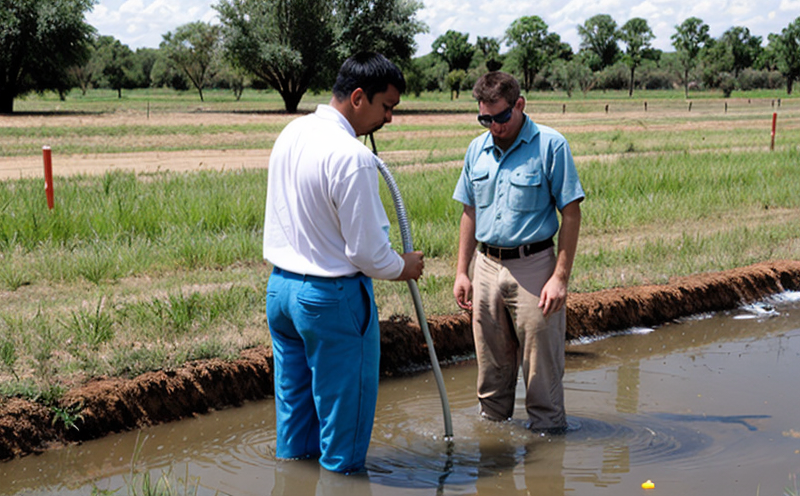ASTM D512 Chloride Determination Test in Groundwater
The ASTM D512 chloride determination test is a critical method used to assess the quality of groundwater, which plays an essential role in environmental testing within the sector of groundwater and aquifer monitoring. This test helps ensure that water meets regulatory standards for drinking water or other specific applications.
Chloride contamination can originate from various sources such as road salt, sewage effluents, industrial discharges, and agricultural runoff. Elevated chloride levels in groundwater can indicate pollution issues and pose health risks if consumed by humans. Therefore, accurate measurement of chloride concentration is vital for environmental monitoring programs.
The ASTM D512 method utilizes a titration technique involving silver nitrate as the titrant and potassium chromate as an indicator to determine free chlorides in water samples. This procedure allows precise quantification even when dealing with complex matrices found in natural waters.
For effective chloride determination, proper sample preparation is crucial. Groundwater samples should be collected following best practices outlined by relevant guidelines such as EPA Method 200.7. Samples must be preserved properly before analysis to prevent any changes in chemical composition that could affect results.
The equipment required includes a burette for titration, distilled water for dilution purposes (if necessary), and appropriate containers for sample collection and storage. Additionally, the analyst needs access to reagents like silver nitrate solution, potassium chromate indicator, and standard calibration solutions prepared according to specified concentrations.
After collecting representative samples from different depths of an aquifer or monitoring wells, they need to be filtered through Whatman filters to remove suspended particles. Then, these filtered samples are ready for analysis using ASTM D512 procedures. It is important to note that the analyst should follow all safety protocols while handling chemicals and performing titrations.
The accuracy of chloride determinations depends heavily on accurate sample preparation techniques and adherence to standard operating procedures during titration steps. Proper calibration of equipment ensures reliable results throughout multiple analyses.
Scope and Methodology
| Step | Action | Description |
|---|---|---|
| 1 | Sample Collection | Groundwater samples are collected from various depths using appropriate devices. Samples should be stored in sealed containers and transported to the laboratory under controlled conditions. |
| 2 | Filtering | Suspended particles are removed by filtering the samples through Whatman filters before analysis. |
| 3 | Titrating | The filtered sample is titrated with silver nitrate solution until a pink color appears, indicating endpoint. The volume of silver nitrate used corresponds to the amount of chlorides present. |
| 4 | Calibration | The calibration curve is prepared using known concentrations of chloride standards to ensure accurate measurements. |
The ASTM D512 method provides a straightforward approach for determining chloride concentrations in groundwater samples. By following strict protocols and ensuring proper sample preparation, analysts can achieve highly reliable results that meet regulatory requirements.
Quality and Reliability Assurance
To maintain high-quality standards throughout the entire testing process, several quality assurance measures are implemented. These include:
- Standard Operating Procedures (SOPs): All laboratory personnel follow detailed SOPs for every step of sample handling and analysis.
- Calibration Checks: Equipment is regularly calibrated using certified reference materials to guarantee accuracy.
- Duplicate Samples: Multiple replicates are analyzed from each batch of samples to verify consistency and minimize errors.
- Internal Controls: Control samples with known chloride concentrations are included in every batch run to monitor performance.
Use Cases and Application Examples
The ASTM D512 chloride determination test finds application across numerous industries, particularly those involved in environmental monitoring. Here are some practical examples:
- Drinking Water Supply: Ensuring compliance with EPA standards for safe drinking water by measuring chlorides in source waters.
- Agricultural Irrigation: Monitoring chloride levels to prevent soil salinization and protect crops from potential damage caused by excess salts.
- Industrial Operations: Detecting accidental discharges into groundwater systems that could contaminate nearby wells or aquifers.
- Environmental Impact Assessments: Evaluating the impact of industrial activities on local groundwater resources before and after project implementation.





